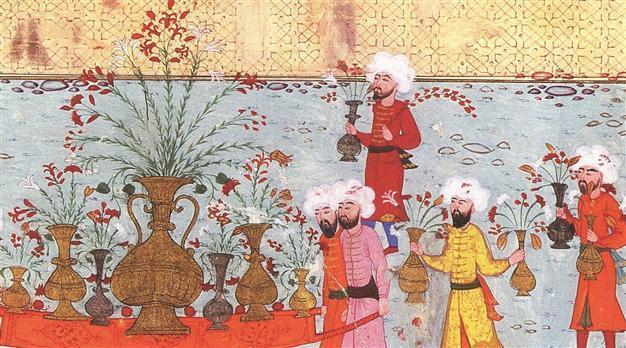Organizing trade: The ahis and guilds of Anatolia
NIKI GAMM

The flower sellers’ guild.
The guild in Ottoman times can be defined as an association of craftsmen and tradesmen who dealt with the same products and who banded together for their mutual benefit. These guild members, who were known as ahis, are supposed to have taken their name from Ahi Evran, a 13th-century leather worker who fled to Anatolia to escape the Mongol invasion of the Middle East. He settled in Konya where he organized the leather workers.The story of Ahi Evran was not written down until the 16th century, and this raises questions about its accuracy. Added to this is the serious debate going on among scholars as to just how the guild system (ahilik) arose in the Islamic world. There is general agreement that the first guilds were organized and given legal status by the Romans. Such guilds would then have existed in the Eastern Roman Empire or, as we more commonly call it today, the Byzantine Empire. They were governed by the state rather than by their own members.
Merchants and tradesmen formed guilds but, as the Byzantines gradually lost their empire to Arab, Mongol and Turkish armies and the power of the Balkan states grew, only the guilds in Constantinople remained. It doesn’t seem possible that Ahi Evran could have patterned his organization on the Byzantine guilds.
No one even knows the origin of the word ahi. Claude Cahen in his book, “Pre-Ottoman Turkey,” attributes the rise of the ahi to Akhi Faraj Zanjani in northwestern Iran in the 11th century. Since the Turks of Central Asia would have traveled through this area, it would not be surprising if they picked up the concept on their way to Anatolia. He points out as well that, when the famous 14th-century traveler Ibn Battuta reached Anatolia, he found ahi organizations everywhere he visited.

The kebab-sellers
What is particularly striking is that the ahi organization came to the fore at approximately the same time as the various mystic Sufi groups gained in popularity in Anatolia. The Mevlevis were just becoming organized in Konya at about the same time that Ahi Evran was active there. The Bektaşis were already spreading out in Anatolia, having been founded earlier in the 13th century by Hacı Bektaş Veli who settled in Kirşehir. Ahi Evran was buried in Kirşehir.
In comparing the ahis with the mystic sects, one should start with their very similar ideals such as the emphasis on telling the truth, providing the highest-quality product, serving people without any expectation of earning money, helping the poor, housing travelers and those with no place to stay and feeding the hungry. The similarity goes further in that there were specific ceremonies related to initiations and the passing from one level to another, especially regarding accumulated knowledge and skill. These ceremonies had a strong religious content with prayers and recitations of verses and chapters of the Quran.
A person’s progress through four main levels started as the assistant (yamak), like someone who swept the floors of the guild’s meeting place, and then proceeded to the apprentice (çırak) and then the qualified workman (kalfa) and finally the master (usta). Within each of these four levels, one would proceed through various stages. This is almost identical to the progress a Sufi had to make in order to reach the highest level of authority in the Sufi lodge.
The ahis also included women’s groups in Anatolia. Ahi Evran’s wife, Fatma, is supposed to have convened some of her woman friends together to form a group that is known as the first women’s professional organization. Their primary focus was to help their husbands, even going to war if necessary. Whenever there was a problem, they would pitch in to help.
Among their professions were goat herding, weaving carpets and rugs, as well as silk and cotton, while they also taught others to make different types of clothing. In a number of cities they had their own meeting places and the remains of these buildings can still be seen in Bursa, Konya and Kayseri, with women in Bursa particularly involved in the silk industry. The women also engaged actively in social affairs; if a girl had lost her parents, they would take her under their protection and teach her skills, preparing her for survival and marriage. They also looked after elderly women who had no family.
As for clothing, the ahis wore a robe known as a hırka or aba, the şalvar (baggy trousers) and mest, a light boot. They gathered their robes with very long belts and wore the sarık or turban to cover their heads. The sarık was made from seven to nine arşin (one arşin equaled approximately 27 inches) of cloth. They had a preference for green, blue, white and black. The green was worn by teachers, judges and members of the ruling class. The bureaucrats and Quran memorizers preferred white, while the person who was at the very lowest level before he became a full ahi wore black. Red and yellow were not preferred, and wearing gold rings was frowned on. Their clothes, however, were rather dressier than those of the Sufis.
Under the Ottomans, the ahi organizations, under the control of a shaykh and a reciter of prayers, consisted of people who worked with their hands such as tinsmiths (tinkers), butchers, tailors, bakers, flower sellers, candle makers and others. The tanners and saddlers were by far the strongest of the guilds in Istanbul. Prices, hours, and places where they could do business were set and an apprenticeship system for training the next generation was maintained. In the 18th century, they were overseen by a kethuda or steward who had to be approved by the master craftsmen and the government’s central administration, unlike the guilds in the West which were mostly strong enough to be independent.
For centuries as well, each ahi organization had been 100 percent Muslim, but this changed over time as more and more non-Muslims became involved in trade, especially foreign commerce. A change happened toward the end of the 17th century as the ahis became more secularized, perhaps under the influence of non-Muslims. The performance of elaborate religious ceremonies no longer occurred, according to Gibb and Bowen in “Islamic Society and the West.”
Any ahi who violated the law could be punished by the head of his guild including the bastinado, fines and expulsion from the guild. For very serious crimes, the accused would be taken before a judge (see Uriel Heyd, “Studies in Old Ottoman Criminal Law”). Some particularly powerful guilds such as the saddlers claimed to have a decree from Mehmed the Conqueror that prevented policemen from entering their shops. According to Evliya Çelebi, in the 17th century, the tanners would not surrender murderers, thieves or robbers who fled to their shops; however, the criminal would be given the dirtiest work until they repented. Then he could become a tanner like them. This privilege was lost in 1826 just months after the Janissary corps was violently dissolved.
The ahi guilds gradually declined, possibly because many of their members had been Janissaries and with the Janissaries gone, they no longer had any strong backers. By 1923 when the republic was declared, there were hardly any left.
















